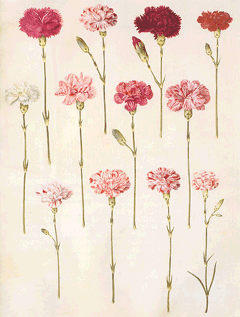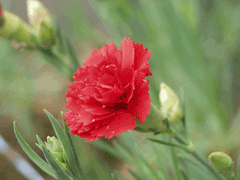 |
|
http://commons.wikimedia.org/wiki/File:Gc17_dianthus_caryophyllus.jpg |
 |
| http://commons.wikimedia.org/wiki/File:W_carnation4051.jpg |
Translate this page:
Summary
Bloom Color: Orange, Pink, Red, White, Yellow.
Main Bloom Time: Mid summer. Form: Upright or erect.
Physical Characteristics

 Dianthus_caryophyllus is a PERENNIAL growing to 1 m (3ft 3in) by 0.5 m (1ft 8in) at a slow rate.
Dianthus_caryophyllus is a PERENNIAL growing to 1 m (3ft 3in) by 0.5 m (1ft 8in) at a slow rate.
See above for USDA hardiness. It is hardy to UK zone 8 and is not frost tender. It is in flower from July to August, and the seeds ripen from August to September. The species is hermaphrodite (has both male and female organs) and is pollinated by Lepidoptera (Moths & Butterflies). The plant is self-fertile.
It is noted for attracting wildlife.
Suitable for: light (sandy), medium (loamy) and heavy (clay) soils and prefers well-drained soil. Suitable pH: mildly acid, neutral and basic (mildly alkaline) soils and can grow in very alkaline and saline soils.
It cannot grow in the shade. It prefers dry or moist soil. The plant can tolerate maritime exposure.
It can tolerate atmospheric pollution.
UK Hardiness Map
US Hardiness Map
Synonyms
Plant Habitats
Edible Uses
The flower petals have a strong smell of cloves and are candied, used as a garnish in salads, for flavouring fruit, fruit salads etc. They can also be used as a substitute for rose petals in making a syrup[183, 238]. The petals should be removed from the calyx and their bitter white base should be removed[183].
References More on Edible Uses
Medicinal Uses
Plants For A Future can not take any responsibility for any adverse effects from the use of plants. Always seek advice from a professional before using a plant medicinally.
Carnation flowers are an aromatic, stimulant herb that has been used in tonic cordials in the past to treat fevers, though this use is now obsolete[238]. It is traditionally prescribed in European herbal medicine to treat coronary and nervous disorders[254]. The flowers are considered to be alexiteric, antispasmodic, cardiotonic, diaphoretic and nervine[240]. The plant has been used as a vermifuge in China[240].
References More on Medicinal Uses
The Bookshop: Edible Plant Books
Our Latest books on Perennial Plants For Food Forests and Permaculture Gardens in paperback or digital formats.

Edible Tropical Plants
Food Forest Plants for Hotter Conditions: 250+ Plants For Tropical Food Forests & Permaculture Gardens.
More

Edible Temperate Plants
Plants for Your Food Forest: 500 Plants for Temperate Food Forests & Permaculture Gardens.
More

More Books
PFAF have eight books available in paperback and digital formats. Browse the shop for more information.
Shop Now
Other Uses
An essential oil is obtained from the flowers[46, 171]. It is used in perfumery. 500kg of flowers produce 100g of oil[61]. The flowers are harvested when they are fully open in the morning, preferably after 3 hours exposure to sunlight[238]. The flower heads are dried and used in pot-pourri, scented sachets and cosmetic products[238, 268]. The plant is quite rich in saponins. The leaves can be simmered in water and this water can then be used as a soap for cleaning the skin, clothes etc[201].
Special Uses
References More on Other Uses
Cultivation details
Landscape Uses:Border, Container, Rock garden, Seashore, Specimen. Succeeds in a sunny position in most good soils[111, 200] tolerating a pH range from 6 to 8 but disliking acid soils[200]. A very tolerant plant, succeeding in the salt laden air and strong winds of the coast as well as in the sulphur polluted air of cities[200]. This species is not hardy in the colder areas of the country, it tolerates temperatures down to about -10°c[200]. A very ornamental plant[1], the carnation is widely cultivated in the flower garden and is grown commercially in France for its essential oil[46]. There are many named varieties[200]. The flowers of the species have a rich clove-like perfume, though almost no scent is present in the orange and yellow-flowering cultivars[245]. The flowers are very attractive to butterflies and moths[17]. Plants are prone to mildew or leaf spot in humid climates[201]. Special Features:Edible, Not North American native, Suitable for cut flowers, Fragrant flowers.
References Carbon Farming Information and Carbon Sequestration Information
Temperature Converter
Type a value in the Celsius field to convert the value to Fahrenheit:
Fahrenheit:
The PFAF Bookshop
Plants For A Future have a number of books available in paperback and digital form. Book titles include Edible Plants, Edible Perennials, Edible Trees,Edible Shrubs, Woodland Gardening, and Temperate Food Forest Plants. Our new book is Food Forest Plants For Hotter Conditions (Tropical and Sub-Tropical).
Shop Now
Plant Propagation
Seed - sow spring in slight heat in a greenhouse[1]. The seed usually germinates in 2 - 3 weeks at 15°c. When they are large enough to handle, prick the seedlings out into individual pots and grow them on in the greenhouse for their first winter. Plant them out into their permanent positions in late spring or early summer, after the last expected frosts. Layering in July[1]. Cuttings of non-flowering basal shoots, June/July in a frame[200]. Harvest the shoots when they are about 10cm long with plenty of underground stem. Pot them up into individual pots and keep them in light shade in a cold frame or greenhouse until they are rooting well. Plant them out in the summer.
Other Names
If available other names are mentioned here
Native Range
Coming Soon
Weed Potential
Right plant wrong place. We are currently updating this section.
Please note that a plant may be invasive in one area but may not in your area so it’s worth checking.
Conservation Status
IUCN Red List of Threatened Plants Status :

Growth: S = slow M = medium F = fast. Soil: L = light (sandy) M = medium H = heavy (clay). pH: A = acid N = neutral B = basic (alkaline). Shade: F = full shade S = semi-shade N = no shade. Moisture: D = dry M = Moist We = wet Wa = water.
Expert comment
Author
L.
Botanical References
200
Links / References
For a list of references used on this page please go here
Readers comment